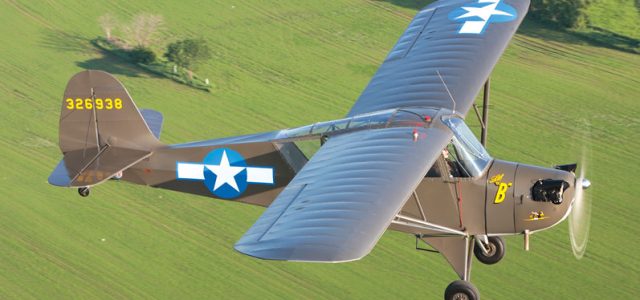In the summer of 1941, with a world war knocking at America’s door, the U.S. Army was itching for a “low and slow” observation plane. The Army wanted one that could loiter near and over the hidden enemy and, when spotted, could then coordinate with artillery units to rain destruction down upon the foe. During the Louisiana war games of 1941, three of the big names in aviation—Taylorcraft, Aeronca, and Piper—showed up to play, each with a proven, off-the-shelf candidate, in hopes of winning a lucrative military contact. The Stinson L-1 Vigilant, already on line, significantly dwarfed the civilian entrants. Needless to say, “bigger” was not better, as the little “grasshoppers” won the day.
As with all military aircraft, the three contenders were given alphanumeric designations with their fresh coats of Army green paint. The original military letter code for an observation aircraft was “O,” but it was changed to “L” (for “liaison”) in 1942. The “L-birds” were all fabric covered, similar in length and wingspan, and carried a pilot and observer seated in tandem surrounded by a glass greenhouse. The same well-built and proven “bulletproof engine,” the Continental A-65, powered most of the early models, until the purpose-built Stinson L-5 arrived with a bigger airframe and bigger Lycoming O-435 190hp engine.
STINSON L-1 VIGILANT
The Stinson L-1 Vigilant was equipped with full-span automatic slats on the leading edges of the wings and pilot-operated slotted flaps on the trailing edges. Thus, Vigilants were well suited for operations from short fields. With a length of more than 34 feet and a wingspan of almost 51 feet, the top speed of the liaison giant was around 122mph via a 295hp Lycoming R-680 radial engine.
During WW II, the Vigilant was used in a variety of roles, including towing gliders, spotting artillery, undertaking rescue missions, supplying front-line troops, and conducting clandestine missions behind enemy lines. Some Vigilants were converted as air ambulances, with a set of litters in the rear to carry wounded soldiers to field hospitals. Whether on wheels, skis, or floats, the Vigilant was able to carry out its mission when called upon.
Read the article from the December 2017 issue of Flight Journal, click here.
















